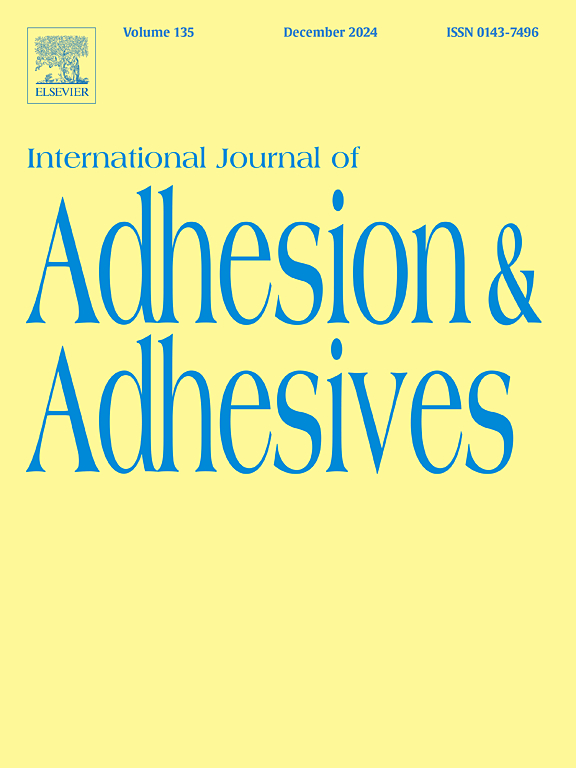Catechin-doped universal adhesive system: Physicochemical characterization and resin-dentin bonding stability
IF 3.2
3区 材料科学
Q2 ENGINEERING, CHEMICAL
International Journal of Adhesion and Adhesives
Pub Date : 2025-04-19
DOI:10.1016/j.ijadhadh.2025.104037
引用次数: 0
Abstract
Objectives
To evaluate the influence of EGCG on the physicochemical properties of a universal adhesive and the stability of the resin-dentin interfaces.
Methods
An experimental adhesive was obtained by adding 0.1 % EGCG w/w to Single Bond Universal. Adhesive specimens were assayed following ISO recommendations for flexural strength, water sorption and solubility experiments. The degree of conversion (DC) was analyzed by FTIR. Data were statistically analyzed using a T-test (p < 0.05). Subsequently, the teeth were randomly allocated to four groups (n = 9): controls (ER and SE) and experimentals (ER-EGCG and SE-EGCG), prepared to bonding and sectioned to obtain bonded sticks to test in the universal machine immediately, after 6 and 12 months. Mean μTBS values were subjected to two-way ANOVA and Student-Newman-Keuls test (p < 0.05). Dentin micropermeability and interfacial nanoleakage were assessed using a confocal-laser scanning microscope and scanning electron microscope.
Results
EGCG-dopped adhesive showed higher values of modulus of elasticity (ME) (p < 0.05) and lower values of WS (p < 0.05). After 24 h, mean bond strength values were not significantly different among all groups (p > 0.05). The SE-EGCG showed higher mean bond strength value when compared to control at 12 months of storage (p < 0.05). CLSM technique and nanoleakage expression showed better results in SE groups.
Conclusion
EGCG does not affect the physicochemical properties of SBU and presents a positive effect on bond strength when used in the SE strategy, which could improve the durability of the dentin-resin bond over time.
Clinical significance
EGCG incorporated into a universal adhesive for inhibition of hybrid layer degradation does not present a negative effect on the physicochemical properties of the adhesive system.
儿茶素掺杂万能胶粘剂体系:物理化学表征及树脂-牙本质粘合稳定性
目的评价EGCG对通用胶粘剂的理化性质及树脂-牙本质界面稳定性的影响。方法在Single Bond Universal中加入0.1% EGCG (w/w)制备实验胶粘剂。粘接剂试样按照ISO建议进行抗弯强度、吸水率和溶解度试验。用FTIR分析了其转换度。数据采用t检验进行统计学分析(p <;0.05)。随后,将牙齿随机分为4组(n = 9):对照组(ER和SE)和实验组(ER- egcg和SE- egcg),分别在6个月和12个月后进行粘接和切片,获得粘接棒,立即在万能机上进行测试。平均μTBS值经双因素方差分析和Student-Newman-Keuls检验(p <;0.05)。采用共聚焦激光扫描显微镜和扫描电镜观察牙本质微渗透性和界面纳米渗漏情况。结果segcg掺杂的胶粘剂具有较高的弹性模量(ME)值(p <;0.05), WS值较低(p <;0.05)。24 h后,各组间平均粘结强度值差异无统计学意义(p >;0.05)。与对照组相比,SE-EGCG在12个月的储存中显示出更高的平均粘接强度值(p <;0.05)。CLSM技术和纳米渗漏表达在SE组表现出较好的效果。结论egcg不影响SBU的物理化学性质,在SE策略中使用时对牙本质-树脂结合强度有积极的影响,可以提高牙本质-树脂结合的耐久性。临床意义egcg加入到通用粘合剂中抑制杂化层降解不会对粘合剂系统的物理化学性质产生负面影响。
本文章由计算机程序翻译,如有差异,请以英文原文为准。
求助全文
约1分钟内获得全文
求助全文
来源期刊

International Journal of Adhesion and Adhesives
工程技术-材料科学:综合
CiteScore
6.90
自引率
8.80%
发文量
200
审稿时长
8.3 months
期刊介绍:
The International Journal of Adhesion and Adhesives draws together the many aspects of the science and technology of adhesive materials, from fundamental research and development work to industrial applications. Subject areas covered include: interfacial interactions, surface chemistry, methods of testing, accumulation of test data on physical and mechanical properties, environmental effects, new adhesive materials, sealants, design of bonded joints, and manufacturing technology.
 求助内容:
求助内容: 应助结果提醒方式:
应助结果提醒方式:


